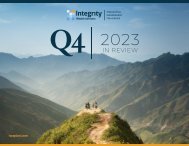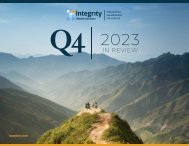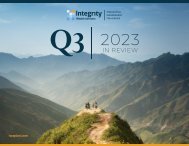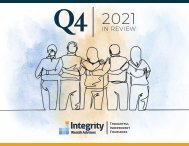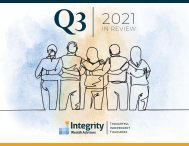You also want an ePaper? Increase the reach of your titles
YUMPU automatically turns print PDFs into web optimized ePapers that Google loves.
<strong>Q1</strong><br />
<strong>2024</strong><br />
IN REVIEW<br />
iwaplan.com
TOTAL RETURN <strong>2024</strong> <strong>Q1</strong> + NEWSWORTHY EVENTS<br />
January 11 – Securities<br />
and Exchange Commission<br />
approves the first spot Bitcoin<br />
exchange-traded funds to be<br />
listed on U.S. exchanges<br />
February 14 – Consumer Price<br />
<strong>In</strong>dex (CPI) for January showed that<br />
prices increased 0.3% on a monthto-month<br />
basis and 3.1% over the<br />
trailing 12-month period, slightly<br />
above Wall Street’s expectations<br />
March 14 – Bitcoin reaches<br />
all time high of $73,000<br />
March 19 – Cocoa prices<br />
reach an all-time high of<br />
$9,000 per ton, surpassing<br />
the price of Copper<br />
March 26 – A container ship<br />
collides with the Francis Scott<br />
Key Bridge in Baltimore causing<br />
a total collapse of the bridge<br />
and the deaths of six people<br />
January 31 – Chairman Jerome<br />
Powell said that he would like to<br />
see more progress on the inflation<br />
front and threw some cold water<br />
on sentiment that the Fed will pivot<br />
in March and begin cutting rates<br />
February 22 – Stock market<br />
shoots higher on the strength of<br />
blowout quarterly results from<br />
semiconductor giant NVIDIA<br />
March 20 – Federal Open Market<br />
Committee (FOMC) left the federal<br />
funds rate unchanged at 5.25% to<br />
5.50% and said that the possibility<br />
of three interest-rate cuts in <strong>2024</strong><br />
remains on the table<br />
S&P 500 TOTAL RETURN<br />
MSCI ACWI EX USA TOTAL RETURN<br />
BARCLAYS US AGGREGATE TOTAL RETURN<br />
12%<br />
10%<br />
10.55%<br />
8%<br />
6%<br />
4.66%<br />
4%<br />
2%<br />
0%<br />
-0.77%<br />
-2%<br />
-4%<br />
January<br />
February<br />
March<br />
As of close 3/31/<strong>2024</strong><br />
12%<br />
S&P 500 TOTAL RETURN<br />
MSCI ACWI EX USA TOTAL RETURN<br />
BARCLAYS US AGGREGATE TOTAL RETURN<br />
Source: https://en.wikipedia.org/wiki/<strong>2024</strong><br />
11%<br />
10.42%
ECONOMIC CHARTS & NOTES<br />
<strong>2024</strong><br />
<strong>Q1</strong><br />
IN REVIEW<br />
CONSUMER SENTIMENT The Consumer Sentiment index held onto recent<br />
gains, a sign that Americans are feeling more confident about the economy and<br />
year-ahead business conditions.<br />
US Retail Sales % Chg<br />
34%<br />
28%<br />
22%<br />
16%<br />
10%<br />
EMPLOYMENT The U.S. unemployment rate has been below 4% for 25 straight<br />
months, the longest such streak since the 1960's. Payroll employment rose by 275k<br />
in February led by job gains in healthcare, government, and restaurants.<br />
Unemployment Rate %<br />
4%<br />
-2%<br />
-8%<br />
-14%<br />
Jan '19<br />
16%<br />
14%<br />
12%<br />
10%<br />
8%<br />
6%<br />
4%<br />
Jul '19<br />
Jan '20<br />
US Retail Sales<br />
Jul '20<br />
Jan '21<br />
Jul '21<br />
Unemployment Rate<br />
Jan '22<br />
Jul '22<br />
Consumer Sentiment<br />
Jan '23<br />
Jul '23<br />
NonFarm Payroll<br />
Jan '24<br />
Source: University of Michigan Consumer Sentiment. Retail Sales - U.S. Census Bureau.<br />
100<br />
90<br />
80<br />
70<br />
60<br />
50<br />
2200<br />
-825<br />
-3850<br />
-6875<br />
-9900<br />
-12925<br />
-15950<br />
-18975<br />
Consumer Sentiment<br />
NonFarm Payroll<br />
The first quarter of <strong>2024</strong> was a "tale of two cities," so to speak,<br />
with the stock market going in one direction and the bond<br />
market in the other. Meanwhile, the economy continues to defy<br />
the doubters as economists and even the Fed raised growth<br />
expectations for the rest of <strong>2024</strong>. While this was good news for<br />
the stock market (the S&P500 index was up an impressive 10% for<br />
the first quarter) it was not so sweet for the bond market (down<br />
nearly 1% in the first quarter) as concerns over sticky inflation<br />
worried investors that the Fed wouldn't lower rates anytime soon.<br />
This "higher for longer" outlook on interest rates pushed the 10-<br />
year treasury yield up to 4.34%, which sent existing bond prices<br />
lower.<br />
My take? While it is true the Fed may not lower interest rates any<br />
time soon, looking at their own "Dot Plot," it's clear that cuts are<br />
on the way. It just might not be as quickly as the markets were<br />
expecting. <strong>In</strong> the meantime, the economy continues to do well.<br />
Note that the <strong>In</strong>dex of Leading Economic <strong>In</strong>dicators (LEI), after<br />
bottoming in mid to late 2023, has been moving up steadily since<br />
then. Add in the strong job market, and it's difficult to imagine a<br />
recession anytime soon. The bottom line is that while there will<br />
surely be volatility in <strong>2024</strong>, the environment for stocks and bonds<br />
will remain healthy. Thank you for taking the time to read our<br />
Quarterly <strong>Review</strong>. On behalf of the entire <strong>In</strong>tegrity <strong>Wealth</strong> team, we<br />
hope you enjoy this <strong>Q1</strong> <strong>2024</strong> edition.<br />
Warm Regards,<br />
2%<br />
Jan ' 19<br />
Jul '19<br />
Jan '20 Jul '20 Jan '21 Jul '21 Jan '22 Jul '22 Jan '23<br />
Source: U.S. Bureau of Labor Statistics<br />
Jul '23<br />
Jan '24<br />
-22000<br />
Stephen H. Wagner, CFP®, CEPA®<br />
<strong>In</strong>vestment Committee Chair
ECONOMIC CHARTS & NOTES<br />
CONSUMER PRICE INDEX Consumer prices are up 3.2% from a year ago<br />
as inflation continues to moderate from 2022 peak levels. However, a recent<br />
uptick in inflation has the Fed holding off on interest rate cuts.<br />
CONSUMER SPENDING Adjusted for inflation, disposable personal income<br />
and spending are up from last year. Higher wages and easing inflation are<br />
increasing household spending power.<br />
Y/Y % Chg<br />
8%<br />
7%<br />
6%<br />
5%<br />
4%<br />
3%<br />
2%<br />
1%<br />
0%<br />
CPI Less Food<br />
CPI All<br />
2018 2019 2020 2021<br />
2022 2023<br />
% Chg Year-over-year<br />
35<br />
30<br />
25<br />
20<br />
15<br />
10<br />
5<br />
0<br />
-5<br />
-10<br />
-15<br />
-20<br />
-25<br />
Jan '19<br />
Consumption<br />
Disposable <strong>In</strong>come<br />
Jul '19 Jan '20 Jul ' 20 Jan '21 Jul '21 Jan '22 Jul '22 Jan '23 Jul '23 Jan '24<br />
Source: U.S. Bureau of Labor Statistics<br />
Source: U.S. Bureau of Economic Analysis<br />
JOB OPENINGS & HIRES Retail hiring and job openings are down from last<br />
year as stores adjust staff levels following a strong holiday shopping season<br />
and workers shift to other sectors.<br />
GDP The resilient U.S. economy shrugged off high interest rates to grow 3.4% in<br />
2023 Q4. Real GDP growth in <strong>Q1</strong> is forecast to be around 2.3%.<br />
Retail Openings<br />
Retail Hires<br />
GDP<br />
Amount in Thousands<br />
1500<br />
1200<br />
900<br />
600<br />
300<br />
0<br />
Jan '19<br />
Jul '19<br />
Jan '20<br />
Jul '20<br />
Jan '21<br />
Jul '21<br />
Jan '22<br />
Jul '22<br />
Jan '23<br />
Jul '23<br />
Jan '24<br />
% Growth<br />
35%<br />
30%<br />
25%<br />
20%<br />
15%<br />
10%<br />
5%<br />
0%<br />
-5%<br />
-10%<br />
-15%<br />
-20%<br />
-25%<br />
-30%<br />
<strong>Q1</strong> Q2 Q3 Q4 <strong>Q1</strong> Q2 Q3 Q4 <strong>Q1</strong> Q2 Q3 Q4 <strong>Q1</strong> Q2 Q3 <strong>Q1</strong> Q4 Q2 Q3 Q4 <strong>Q1</strong> Q2 Q3 Q4<br />
2018<br />
2019 2020 2021 2022 2023<br />
Source: U.S. Bureau of Labor Statistics<br />
Source: U.S. Bureau of Economic Analysis
A COMPELLING ENTRY POINT FOR BONDS<br />
<strong>2024</strong><br />
<strong>Q1</strong><br />
IN REVIEW<br />
This chart demonstrates the compelling nature of today’s fixed-income entry point.<br />
It outlines the potential returns across various fixed-income sectors based on<br />
current yields and illustrative interest rate movements. This analysis reveals that<br />
current starting yields may help anchor bond return potential at attractive levels<br />
while also providing a cushion against any further increases in interest rates.<br />
For example, in the multisector bond category below, if <strong>2024</strong> follows a similar path<br />
as 2023 and rates end where they start, return expectations are a healthy 6%. If<br />
rates rise, they must hit nearly 7% (an increase of over 200 basis points (bps)) to<br />
turn estimated multisector returns negative.<br />
Categories with more duration or interest rate sensitivity, such as core bonds<br />
and investment-grade municipals, may also offer a compelling trade-off. Unlike<br />
2022, when starting yields were much lower, returns today are likely to remain<br />
positive even with modest further increases in rates. However, if rates fall even one<br />
percentage point, returns could climb into double digits.<br />
That round trip in yields allowed bonds to end 2023 on a high note, with returns<br />
in the mid to high single digits, as starting yields drove attractive returns. <strong>In</strong> fact,<br />
across most major fixed-income sectors, a majority of 2023 returns were driven by<br />
yield as opposed to price movements. The rally in interest rates in November and<br />
December simply erased price losses from rising rates earlier in the year.<br />
Additionally, though rates rose through October, most fixed-income sectors<br />
remained positive or only dipped modestly into negative territory as income from<br />
higher yields helped offset price losses. That was not the case in 2022 when much<br />
lower starting yields and stronger movements in interest rates and spreads drove<br />
most fixed-income sectors into negative territory. Notably, beginning yields in <strong>2024</strong><br />
are much closer to the high levels of 2023 than the lows of 2022. For example,<br />
while the Bloomberg US Aggregate Bond <strong>In</strong>dex yield stood at 1.70% to start 2022,<br />
those levels were 4.65% and 4.52% to start 2023 and <strong>2024</strong>, respectively.<br />
The one category that shouldn’t benefit<br />
from falling rates is cash investments, as a<br />
decline in short rates can quickly translate<br />
to a decline in investor returns. That’s not<br />
to mention the potential opportunity cost<br />
missed by not participating in the drop-in<br />
interest rates and the likely rally one would<br />
experience across most fixed-income<br />
sectors.<br />
Last year was a clear reminder of the<br />
pivotal role that high starting yields play<br />
in mitigating downside risks and driving<br />
positive returns in fixed income. Despite the<br />
significant intra-year move in rates, with the<br />
10-year yield briefly touching 5% in October,<br />
many yields further out on the curve ended<br />
the year roughly where they began. The<br />
10-year yield started and ended the year at<br />
precisely the same level of 3.88%.<br />
SOURCE: Bloomberg and PIMCO. For illustrative purposes only. Figure is not indicative of the past or future results of any PIMCO product or strategy. There is no assurance that the stated results will be achieved.
UNDERSTANDING AI HYPE<br />
A framework for investing in the AI opportunity set<br />
perspectives. That said, a potentially useful investment framework that helps to<br />
define near and long-term opportunities is set out below.<br />
<strong>In</strong> 2023, we observed a significant<br />
acceleration in the future value creation<br />
from artificial intelligence, a trend that<br />
was reflected in the share prices of<br />
companies potentially set to benefit<br />
from this multi-generational opportunity.<br />
To navigate this landscape, it's crucial<br />
to separate short-term hype from the<br />
longer-term investment opportunity.<br />
As AI continues to gain momentum,<br />
developing an investment framework<br />
to clarify AI opportunities over different<br />
time horizons is essential. At present,<br />
such a framework could include<br />
computing, infrastructure, models and<br />
applications, and beneficiaries. We firmly<br />
believe that a research-based approach<br />
is the key to identifying potential winners<br />
and avoiding the losers in this everevolving<br />
field.<br />
COMPUTE:<br />
Semiconductors are the brains behind AI,<br />
which is compute-intensive at both the<br />
training and inference stages. Although<br />
semiconductors' growth remains cyclical,<br />
the long-term growth trajectory for<br />
this sector remains exponential, and<br />
the market could almost double from<br />
approximately US $500 billion in 2022 to<br />
more than US $1 trillion by the end of the<br />
decade. A significant amount of this will<br />
likely be driven by increasing computing<br />
demands from AI.<br />
INFRASTRUCTURE:<br />
If semiconductors are the fundamental<br />
building blocks of AI, then companies<br />
providing the infrastructure are the<br />
'plumbing.' This includes public cloud<br />
hyperscalers (such as Microsoft's Azure),<br />
SOURCE: Capitol Group<br />
which allow companies<br />
to outsource computing<br />
to the cloud through<br />
huge data centers. The<br />
advantage of this is<br />
that customers have<br />
Chip designers & providers Cloud hyperscalers<br />
on-demand, pay-peruse<br />
access to the most<br />
Foundries<br />
Datacentres<br />
Manufacturing equipment<br />
Networking<br />
advanced and powerful<br />
computing services<br />
AI ‘stack’<br />
and do not have to<br />
run them on-premise.<br />
<strong>In</strong>frastructure also<br />
includes companies<br />
providing hardware<br />
such as networking<br />
components and switchgear, as well as allocating vast sums of capital to these<br />
software that makes cloud computing models, we only expect a small number<br />
• Compute<br />
more efficient, given AI's high speed and will be able to compete sustainably<br />
bandwidth requirement.<br />
due to the scale requirements and<br />
high barriers to entry − and therefore,<br />
MODELS AND APPLICATIONS:<br />
Much hype surrounding AI is<br />
concentrated on companies 'creating'<br />
AI models. These include names such<br />
as OpenAI, which has garnered plenty of<br />
interest given the success of ChatGPT.<br />
Looking at model developers, we are<br />
wary of potential commoditization<br />
given a large and growing open-source<br />
AI community advocating the 'AI for<br />
Humanity' concept. Data possession<br />
is likely to prove the most important<br />
criteria for identifying ultimate winners<br />
in this space, which naturally favors<br />
owners of large, unique, proprietary<br />
datasets, such as the tech incumbents.<br />
Making a state-of-the-art generalpurpose<br />
foundational model also takes<br />
billions of dollars and talent from a<br />
scarce pool. While many start-ups are<br />
Compute <strong>In</strong>frastructure Models Applications<br />
Beneficiaries<br />
Potentially limitless<br />
Foundational models<br />
Platforms<br />
‘Big Data’ owners<br />
Software<br />
IT Services<br />
Physical applications<br />
as Uber or Airbnb would emerge and<br />
become everyday services. With AI, our<br />
current imagination of what applications<br />
Semiconductors are the brains behind could AI, which be possible is compute-intensive is based on at both our the<br />
training and inference stages. Although limited semiconductors understanding remain of growth this nascent cyclicals,<br />
predict a small the handful long-term of massive growth trajectory for this technology. sector remains exponential and the<br />
winners in the AI market model could area. almost Moving double to from approximately US $500billion in 2022 to more<br />
applications, analysts than US $1trillion believe by software the end of the decade BENEFICIARIES:<br />
4 . A significant amount of this is likely<br />
companies' productizing' to be driven by AI increasing could benefit compute demands from AI.<br />
meaningfully and fast; those winners<br />
Finally, underneath this investment<br />
framework sits the real-life and endindustry<br />
beneficiaries of AI, which could<br />
ultimately be limitless in scope and play<br />
will have a direct monetization lever<br />
by raising prices substantially. • <strong>In</strong>frastructure The<br />
opportunity for If developers semiconductors to provide are the fundamental out building over multiple blocks of generations. AI, then companies Again,<br />
consumer or enterprise-grade providing the infrastructure software are the however, ‘plumbing’. it This important includes public to cloud remember AI<br />
incorporating AI hyperscalers functionality (such is as clear: Microsoft’s Azure), is still which at an allow early companies stage of to outsource development:<br />
consider how a compute company to the like cloud Microsoft through huge it datacentres. remains uncertain The advantage what of the this is technology<br />
that<br />
can add AI to its customers 365-suite, have including on-demand, pay-per-use could access look like to the in most 10 years, advanced how and long it<br />
Outlook, Word, powerful Excel, and compute PowerPoint, services and do not might have take to run for it consumers premise. to build trust,<br />
and charge a substantial <strong>In</strong>frastructure recurring also includes companies and providing how interwoven hardware such in our as networking everyday<br />
premium. We expect components this segment and switchgear, of the as well lives as software AI applications that makes cloud could computing become. We<br />
value chain to evolve more efficient, profoundly given the over high the speed remain and bandwidth focused requirement on opportunities of AI. that<br />
next decade, based on experience with may come out of AI and believe a deep<br />
previous paradigms. <strong>In</strong> the early years research-based approach will become<br />
of smartphones, for • example, Models and few applications could even more critical to identifying potential<br />
have predicted that applications such winners and avoiding losers.<br />
Much of the current hype surrounding AI is concentrated in companies ‘creating’<br />
the AI models. These include names such as OpenAI, which has garnered plenty<br />
of interest given the success of ChatGPT.<br />
Looking at model developers, we are wary of potential commodisation given a<br />
large and growing open-source AI community advocating the ‘AI for Humanity’<br />
4<br />
Data as at 31 December 2022. Source: ASML
WORRIED ABOUT THE<br />
ELECTIONS? HISTORY<br />
TELLS US YOU DON’T<br />
NEED TO BE STRESSED<br />
ABOUT YOUR<br />
PORTFOLIO<br />
Something everyone can agree on? The market has done well irrespective of who is in<br />
the White House/controls Congress, although outperforms under split government<br />
Partisan PARTISAN Control, CONTROL, Avg. Annual AVG ANNUAL S&P Performance<br />
(1933-2023) S&P PERFORMANCE (1933-2023)<br />
16%<br />
14%<br />
12%<br />
10%<br />
8%<br />
6%<br />
4%<br />
15.7%<br />
13.7%<br />
13.0% 12.9%<br />
<strong>2024</strong><br />
<strong>Q1</strong><br />
IN REVIEW<br />
9.0%<br />
4.9%<br />
<strong>In</strong> election years, it's natural to feel uneasy about the impact<br />
on our investments. However, history offers reassuring<br />
insight. Over the long term, the stock market has shown<br />
resilience regardless of political cycles. Despite short-term<br />
volatility, market fundamentals tend to outweigh political<br />
shifts. <strong>In</strong>vestors who maintain a diversified portfolio and stay<br />
focused on long-term goals historically weather electoral<br />
uncertainties. Thus, while elections may spark concerns,<br />
maintaining a steady investment strategy often proves wise<br />
in navigating market fluctuations.<br />
2%<br />
0%<br />
As of January <strong>2024</strong><br />
GROWTH OF $10,000 IN THE S&P 500 INDEX SINCE 1949<br />
Source: Bloomberg, US House of Representatives<br />
GROWTH OF $10,000 IN THE S&P 500 INDEX SINCE 1949<br />
$4,000,000<br />
D Sen/<br />
R House/<br />
D President<br />
Fully invested<br />
R Sen/<br />
D House/<br />
R President<br />
R Congress/<br />
D President<br />
R Congress/<br />
R President<br />
D Congress/<br />
D President<br />
D Congress/<br />
R President<br />
10<br />
$3,500,000<br />
Only <strong>In</strong>vested During a Republican President<br />
Only <strong>In</strong>vested During a Democratic President<br />
$3,000,000<br />
$2,500,000<br />
$2,000,000<br />
$1,500,000<br />
$1,000,000<br />
$500,000<br />
$0<br />
1949 1954 1959 1964 1969 1974 1979 1984 1989 1994 1999 2004 2009 2014 2019 <strong>2024</strong><br />
Source: Standard & Poor’s, FT <strong>Advisors</strong>. Data is quarterly from 1949 – 3/28/<strong>2024</strong>.<br />
SOURCE: Standard & Poor’s, FT <strong>Advisors</strong>. Data is quarterly from 1949 – 3/28/<strong>2024</strong>. Past Past performance is no is guarantee no guarantee of future results. of For illustrative future purposes results. only and not For indicative illustrative of any actual investment. purposes The S&P 500 only <strong>In</strong>dex is and unmanaged not indicative index of 500 companies of used any to measure actual large-cap investment. U.S. stock market performance. The S&P <strong>In</strong>vestors 500 cannot invest <strong>In</strong>dex<br />
directly in an index. <strong>In</strong>dex returns do not reflect any fees, expenses, or sales charges. These returns were the result of certain market factors and events which may not be repeated in the future.<br />
is an unmanaged index of 500 companies used to measure large-cap U.S. stock market performance.<br />
The information presented<br />
<strong>In</strong>vestors<br />
is not intended to constitute<br />
cannot<br />
an investment<br />
invest<br />
recommendation<br />
directly<br />
for, or<br />
in<br />
advice<br />
an<br />
to,<br />
index.<br />
any specific person.<br />
<strong>In</strong>dex<br />
By providing<br />
returns<br />
this information,<br />
do not<br />
First Trust<br />
reflect<br />
is not undertaking<br />
any<br />
to<br />
fees,<br />
give advice<br />
expenses,<br />
in any fiduciary capacity<br />
or<br />
within<br />
sales<br />
the meaning<br />
charges.<br />
of ERISA, the<br />
These<br />
<strong>In</strong>ternal Revenue<br />
returns<br />
Code or any<br />
were the result of certain market factors and events which may not be repeated in the future. other regulatory Bloomberg, framework. Financial US professionals House are of responsible Representatives<br />
for evaluating investment risks independently and for exercising independent judgment in determining whether investments are appropriate for their clients.<br />
Not FDIC <strong>In</strong>sured | Not Bank Guaranteed | May Lose Value<br />
First Trust Portfolios L.P. | Member SIPC | Member FINRA | 1-800-621-1675 | www.ftportfolios.com
INVESTMENT<br />
MANAGEMENT<br />
PHILOSOPHY<br />
The complex, ever-changing investment world of today<br />
requires an investment process that is overseen by a team<br />
of experienced investment professionals. Global capital<br />
markets present investors with a host of challenges due to<br />
the combination of an overwhelming amount of information<br />
to analyze and the endless supply of conflicting opinions and<br />
narratives surrounding financial markets. The time and expertise<br />
required to perform in-depth investment research and to make<br />
timely and informed portfolio management decisions requires<br />
both a clear investment process and an experienced investment<br />
team to implement the process.<br />
An old adage states that there is accomplishment through<br />
many advisors. We agree and embrace a variety of investment<br />
perspectives through our investment committee. Our investment<br />
philosophy is well grounded in global macro-economic analysis.<br />
<strong>In</strong>vestment ideas are carefully vetted through a process which<br />
incorporates the diverse range of investment backgrounds<br />
within our firm. This process of multifaceted analysis ensures<br />
that only the strongest investment ideas survive. We are<br />
committed to striking the right balance between risk and<br />
return through managing global, multi-asset class investment<br />
portfolios.<br />
INDEPENDENCE &<br />
CLIENT FOCUS<br />
DIVERSIFICATION<br />
TOP-DOWN, THEMATIC<br />
APPROACH<br />
PERFORMANCE WITH<br />
LIQUIDITY<br />
VARIED INVESTMENT<br />
PERSPECTIVES<br />
OPTIMIZATION OF<br />
EXPENSES AND TAXES<br />
THE INVESTMENT PROCESS<br />
ASSESSMENT OF GLOBAL<br />
ECONOMIC & INVESTMENT<br />
ENVIRONMENT<br />
ASSESS & ANALYZE<br />
THEMES<br />
RESEARCH INVESTMENT<br />
VEHICLES TO FIND<br />
EFFECTIVE IMPLEMENTATION<br />
IDENTIFY<br />
OPPORTUNITIES<br />
STRATEGIC ASSET<br />
ALLOCATION -<br />
Geographies, Sectors,<br />
Capitalizations<br />
INVESTMENT SELECTION -<br />
Open/Closed End Funds, ETFs, Stocks & Bonds
INVESTMENT COMMITTEE<br />
<strong>2024</strong><br />
<strong>Q1</strong><br />
IN REVIEW<br />
The <strong>In</strong>vestment Committee meets formally each quarter, informally weekly, and more frequently if market conditions warrant to discuss the state of the global<br />
economy and capital markets and assess our portfolios' current asset allocation and positioning. There's an art to striking the right balance between risk and return;<br />
pursuing that symmetry is the core of our investment philosophy. We are fiduciaries and have our interests aligned with our advisory clients' interests as we invest<br />
alongside them. Contact us at investmentcommittee@iwaplan.com with any questions or concerns.<br />
STEPHEN WAGNER<br />
CEO, <strong>In</strong>vestment Advisor,<br />
CFP ® , CEPA ®<br />
LAINE MILLER<br />
<strong>In</strong>vestment Advisor &<br />
Financial Planner, CFP ®<br />
BOB CHEATHAM<br />
Financial Planner,<br />
CRPS®, MA<br />
DOUG ECKER<br />
<strong>In</strong>vestment Advisor &<br />
Financial Planner, CRPS®<br />
CHRISTOPHER WAGNER<br />
<strong>In</strong>vestment Advisor &<br />
Financial Planner<br />
* <strong>In</strong>vestment Advisory Services are offered through investment advisor representatives of <strong>In</strong>tegrity <strong>Wealth</strong> <strong>Advisors</strong>, a Federally Registered <strong>In</strong>vestment Advisor.<br />
Bob Cheatham, Doug Ecker, Laine Miller, and Christopher Wagner are solely investment advisor representatives of <strong>In</strong>tegrity <strong>Wealth</strong> <strong>Advisors</strong>. LLC. and not affiliated with LPL Financial.<br />
Cheers to Martha Laff as she embarks on a joyful<br />
retirement journey! Her invaluable contributions to<br />
the investment committee and years of successful<br />
financial planning have left a lasting impact on her<br />
clients' lives. Here's to new beginnings, relaxation,<br />
and cherished moments ahead!<br />
THOUGHTFUL<br />
INDEPENDENT<br />
FIDUCIARIES<br />
<strong>In</strong>tegrity <strong>Wealth</strong> <strong>Advisors</strong><br />
is committed to helping<br />
individuals, families, and<br />
businesses grow, preserve,<br />
and distribute wealth.<br />
VENTURA<br />
196 S Fir St, Ste 140<br />
<strong>Ventura</strong>, CA 93001<br />
(805) 339-0760<br />
ventura@iwaplan.com<br />
OJAI<br />
205 S Signal St,<br />
<strong>Ojai</strong>, CA 93023<br />
(805) 646-3729<br />
ojai@iwaplan.com
THE IMPACT OF<br />
SOUND FINANCIAL<br />
PLANNING<br />
Recent Vanguard research 1 shows that an<br />
experienced wealth management team not only<br />
adds peace of mind, but also may add about<br />
3 percentage points of value in net portfolio<br />
returns over time. What does this mean? Your<br />
team has the ability and the time to evaluate<br />
your portfolio investments, meet with you to<br />
discuss objectives, and help get you through<br />
tough markets. All of these factored together<br />
potentially add value to your net returns (returns<br />
after taxes and fees) over time. But the most<br />
interesting part of this research is that it shows<br />
that financial planning and financial coaching<br />
contributed to the greater majority of the added<br />
net 3% in net portfolio returns.<br />
It’s important to realize how valuable making<br />
sound financial planning decisions is and that<br />
value is added by your financial planning team.<br />
As investors, our emotions can be our worst<br />
enemy, especially when the markets are volatile,<br />
and guidance from a “behavioral coach” can save<br />
us from panic-selling and abandoning long-term<br />
financial plans. Numerous studies demonstrate<br />
that advisors can have a huge impact on investor<br />
finances, but it’s hard to say if these findings<br />
have been recognized and understood by<br />
everyday investors.<br />
DREAM.<br />
PLAN.<br />
ENJOY.<br />
HOW TO CREATE A CREDIT CARD<br />
DEBT EXIT PLAN<br />
Current credit card debt in the U.S. is over a trillion<br />
dollars, according to the Federal Reserve Bank of<br />
New York. Drilling down to per-person numbers, the<br />
national average unpaid credit card balance stands<br />
at $7,279, Lending Tree reports. A Bankrate survey<br />
reveals that 60% of Americans have carried a credit<br />
card balance for a year or more.<br />
Credit is convenient and almost a necessity these<br />
days. However, credit card debt often grows faster<br />
than we realize. The good news is that you can reverse<br />
the situation. But you need a strategy. Here are four<br />
steps that can help you get out of credit card debt.<br />
1. CALCULATE WHAT YOU OWE TODAY.<br />
Make a spreadsheet that lists each credit card you<br />
have (remember those department store cards).<br />
<strong>In</strong>clude the current balance, interest rate, minimum<br />
payment, credit limit, available credit, and annual fee.<br />
This information can be found in your most recent<br />
statement. Here are a few things to keep in mind:<br />
The annual interest rate. If you haven't looked at it<br />
lately, it may shock you how much it's gone up since<br />
the Federal Reserve started raising interest rates. This<br />
also lists how much interest you've been charged if<br />
you haven't paid your balance in full.<br />
Your credit limit and available credit. Generally, it<br />
would be best if you aimed to use less than 30% of<br />
your available credit to help prevent a dip in your credit<br />
score.<br />
Payment estimate. This shows how long it will take<br />
to pay off your balance if you only make minimum<br />
payments. Here's an example. Let's say you have a<br />
$5,000 balance, with a 20% interest rate, and you pay<br />
$200 a month. To pay off that balance, it would take<br />
almost 12 years and cost you $3,417 in interest!<br />
2. DEVELOP A PAYOFF PLAN.<br />
There are a couple of options to consider when it<br />
comes to paying down credit card debt. One is called<br />
the "avalanche" approach, where you first focus on<br />
the highest interest rate balances. Put most of your<br />
money toward these cards while paying the minimum<br />
SOURCE: Charles Schwab<br />
on the others. This can help you pay off your debt<br />
faster and save money in interest, but it can also be<br />
discouraging since you won't have any big wins right<br />
away.<br />
The second approach is called the "snowball." It<br />
focuses on paying off the lowest balances first. This<br />
can give you some quick wins by helping you build<br />
momentum by paying off some cards faster. The<br />
downside is that paying off your total debt may take<br />
longer and cost more in interest.<br />
3. FOCUS ON TOMORROW.<br />
Staying out of debt is all about tradeoffs. You decide<br />
not to buy something today to put your money<br />
toward something else in the future. What is that<br />
"something"? A special vacation? A home down<br />
payment? An interesting retirement? By keeping<br />
your debt in check now, you're giving yourself<br />
greater freedom of choice later. Think of it as<br />
making tradeoffs—not as deprivation, but as future<br />
abundance.<br />
Again, it's easier if you have a strategy. To me, this<br />
means having a spending plan. Start by taking a<br />
realistic look at where your money's going. Try a<br />
spending tracker to help you keep up with what you're<br />
spending and why. Then, decide what tradeoffs you<br />
need to make. Having a spending plan is freeing<br />
because it puts you in control.<br />
4. START NOW.<br />
Paying off debt may seem overwhelming at first, but<br />
here are some ideas to help you get started:<br />
- Always pay more than the minimum.<br />
- If you're having trouble paying, don't avoid your<br />
lenders. Contact them to discuss your situation.<br />
- Once you've paid down your debt, make it a goal to<br />
pay off new balances by the end of each billing cycle.<br />
Even the most minor steps now will add up. Mark your<br />
progress. Keep your future in focus.
WHAT ARE TAX BRACKETS AND MARGINAL TAX RATES?<br />
Do you know what the federal ordinary income tax<br />
brackets are and the tax rates that apply to you? If you're<br />
unsure, you're not alone. Many believe that the more they<br />
earn, the higher their tax rate will be on all their income.<br />
While it may be true that your tax rate increases with<br />
higher income, it does not mean all your income will be<br />
taxed at a higher rate.<br />
Sound complicated? Fortunately, it's better than it may<br />
seem at first glance. Let's answer a few of the most<br />
common questions regarding tax rates and tax brackets.<br />
WHAT IS A TAX RATE?<br />
A tax rate is simply the percentage at which your income<br />
is taxed. For example, if you were single and had only<br />
$9,000 of taxable income, you'd fall into the 10% federal<br />
tax bracket. To determine your tax, simply multiply the<br />
$9,000 by 10% to get your tax due of $900.<br />
So far, so good. However, there's another important thing<br />
you need to know—the United States has a progressive<br />
tax system. <strong>In</strong> a progressive tax system, the tax rate<br />
increases as your taxable income increases; however,<br />
only the income that passes into the next higher tax<br />
bracket is taxed at a higher tax rate.<br />
WHAT IS A TAX BRACKET?<br />
Currently, there are seven federal tax rates that range<br />
from 10% to 37%. Each of those tax rates only applies to<br />
certain levels of taxable income, known as a tax bracket.<br />
As your taxable income increases, it crosses from one<br />
tax bracket to the next higher tax bracket, where a new<br />
tax rate applies. Even as your income moves into a<br />
higher tax bracket, the income that fell into a lower tax<br />
bracket will still be taxed at those lower tax rates.<br />
The tax brackets that apply to you will depend not only<br />
on your taxable income but also on your filing status<br />
(which includes single filer, married filing jointly, married<br />
filing separately, or head of household). The table shown<br />
displays the tax brackets and corresponding tax rates for<br />
each filing status.<br />
Let's look at an example of how tax rates and brackets<br />
work. We have Sara and Tom, who are married and file<br />
a joint tax return. After taking the standard deductions,<br />
they have taxable income of $125,300. Here's how their<br />
federal taxes will be calculated:<br />
The first $23,200 of their taxable income falls into the<br />
10% tax rate/bracket. That means the tax on this income<br />
is $2,320 ($23,200 x 10%).<br />
Next, $71,100 ($94,300 – $23,200) of taxable income<br />
falls into the 12% tax rate/bracket. The tax on this is<br />
$8,532 ($71,100 x 12%).<br />
Finally, the remaining $31,000<br />
($125,300 – $94,300) of taxable<br />
income falls into the 22% tax rate/<br />
bracket, resulting in $6,820 of taxes.<br />
Sara and Tom's total federal tax will<br />
be about $17,672 ($2,320 + $8,532<br />
+ $6,820). As you can see, Sara and<br />
Tom made their way through three<br />
tax rates/brackets, with a portion of<br />
their income being taxed at 10%, then<br />
at 12%, and the final bit of income<br />
being taxed at 22%. This same<br />
process works no matter how much<br />
income you have. The highest income<br />
taxpayers will progress through all<br />
seven federal tax brackets until they<br />
top out at the 37% tax rate. At this<br />
point, all other income is taxed at the<br />
higher tax rate.<br />
WHAT IS A MARGINAL TAX RATE, AND<br />
WHY DOES IT MATTER?<br />
Your marginal tax rate is the highest<br />
tax rate that applies to you. When you<br />
realize additional income, the taxes<br />
you'll pay on each additional dollar will<br />
be at your marginal tax rate. Knowing<br />
this tax rate comes in handy when it's<br />
time to do some tax planning because<br />
it helps determine which tax strategies<br />
could work best for your situation.<br />
BOTTOM LINE<br />
Remember, these are all just simple<br />
examples of how taxes are calculated.<br />
Many other considerations exist<br />
Tax rate<br />
when determining your total tax bill, such as what other<br />
deductions and credits you're allowed. Also, these<br />
examples only look at federal taxes, and depending on<br />
where you live, state taxes could also be due. We believe<br />
tax planning is an integral part of your overall financial<br />
plan. That's why we recommend meeting with a tax<br />
and/or financial planning professional to get guidance<br />
specific to your situation.<br />
Tax bracket<br />
by filing<br />
status<br />
Single<br />
Tax bracket by filing status<br />
Tax bracket<br />
by filing<br />
status<br />
Married<br />
filing jointly<br />
10% $0 to $11,600 $0 to $23,200<br />
12%<br />
22%<br />
24%<br />
32%<br />
35%<br />
37%<br />
$11,601 to<br />
$47,150<br />
$47,151 to<br />
$100,525<br />
$100,526 to<br />
$191,950<br />
$191,951 to<br />
$243,725<br />
$243,726 to<br />
$609,350<br />
$609,351<br />
and up<br />
$23,201 to<br />
$94,300<br />
$94,301 to<br />
$201,050<br />
$201,051 to<br />
$383,900<br />
$383,901 to<br />
$487,450<br />
$487,451 to<br />
$731,200<br />
$731,201<br />
and up<br />
Tax bracket<br />
by filing<br />
status<br />
Married<br />
filing<br />
separately<br />
$0 to<br />
$11,600<br />
$11,601 to<br />
$47,150<br />
$47,151 to<br />
$100,525<br />
$100,526 to<br />
$191,950<br />
$191,951 to<br />
$243,725<br />
$243,726 to<br />
$365,600<br />
$365,601<br />
and up<br />
SOURCE: Charles Schwab; irs.gov
VENTURA<br />
196 S Fir St, Ste 140<br />
<strong>Ventura</strong>, CA 93001<br />
(805) 339-0760<br />
ventura@iwaplan.com<br />
OJAI<br />
205 S Signal St,<br />
<strong>Ojai</strong>, CA 93023<br />
(805) 646-3729<br />
ojai@iwaplan.com<br />
The S&P 500 <strong>In</strong>dex or the Standard & Poor's 500 <strong>In</strong>dex is a market-capitalization-weighted index of the 500 largest U.S. publicly traded companies. The S&P 500 is<br />
a float-weighted index, meaning company market capitalizations are adjusted by the number of shares available for public trading. <strong>In</strong>vestors cannot invest directly<br />
in an index. Note: <strong>In</strong>vestors cannot invest directly in an index. These unmanaged indices do not reflect management fees and transaction costs that are associated<br />
with most investments.<br />
The MSCI World ex USA <strong>In</strong>dex captures large and mid cap representation across 22 of 23 Developed Markets (DM) countries* – excluding the United States. With<br />
1,012 constituents, the index covers approximately 85% of the free float-adjusted market capitalization in each country.<br />
The Barclays Capital U.S. Aggregate Bond <strong>In</strong>dex is the most common index used to track the performance of investment grade bonds in the U.S.<br />
The opinions expressed in this program are for general informational purposes only and are not intended to provide specific advice or recommendations for any<br />
individual or on any specific security. It is only intended to provide education about the financial industry. To determine which investments may be appropriate for<br />
you, consult your financial advisor prior to investing. Any past performance discussed during this program is no guarantee of future results. Any indices referenced<br />
for comparison are unmanaged and cannot be invested into directly. <strong>In</strong>vesting involves risk and possible loss of principal capital; please seek advice from a licensed<br />
professional.<br />
Vanguard research study; Source: Francis M. Kinniry Jr., Colleen M. Jaconetti, Michael A. DiJoseph, and Yan Zilbering, 2014. Putting a value on your value: Quantifying<br />
Vanguard Advisor’s Alpha. Valley Forge, Pa.: The Vanguard Group.<br />
There is no guarantee that a diversified portfolio will enhance overall returns or outperform a non-diversified portfolio. Diversification does not protect against market<br />
risk. Dollar cost averaging involves continuous investment in securities regardless of fluctuation in price levels of such securities. An investor should consider their<br />
ability to continue purchasing through fluctuating price levels. Such a plan does not assure a profit and does not protect against loss in declining markets.<br />
<strong>In</strong>tegrity <strong>Wealth</strong> <strong>Advisors</strong> is a registered investment adviser. Advisory services are only offered to clients or prospective clients where <strong>In</strong>tegrity <strong>Wealth</strong> <strong>Advisors</strong> and<br />
its representatives are properly licensed or exempt from licensure. No advice may be rendered by <strong>In</strong>tegrity <strong>Wealth</strong> <strong>Advisors</strong> unless a client service agreement is in<br />
place.<br />
Advisory services offered through <strong>In</strong>tegrity <strong>Wealth</strong> <strong>Advisors</strong> (IWA), a registered investment advisor. Certain, but not all, investment advisor representatives (IARs) of<br />
IWA are also registered representatives of, and offer securities through LPL Financial, member FINRA/SIPC. IWA and LPL Financial are separate entities.



